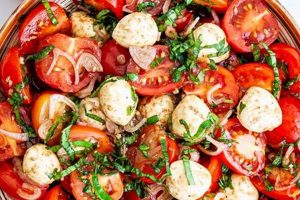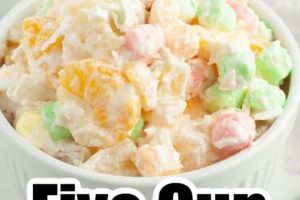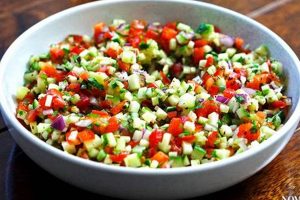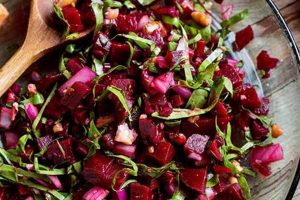A chilled dessert salad typically combines fresh strawberries with a fluffy, creamy base often made from whipped cream, cream cheese, or a combination of both. Other common additions include marshmallows, miniature marshmallows, Cool Whip (a brand of whipped topping), and sometimes Jell-O or pudding mixes. Variations can incorporate other fruits, nuts, or even shortbread cookies. This type of dish is generally served cold and is popular at potlucks, picnics, and holiday gatherings.
This dish offers a simple, refreshing dessert option, particularly well-suited for warm weather. Its versatility allows for easy customization to individual preferences, accommodating dietary restrictions by substituting ingredients. Historically rooted in American cuisine, these types of “salad” recipes became popular in the mid-20th century with the rise of convenience foods and the post-war emphasis on entertaining. They represent a continued tradition of easy-to-assemble dishes focused on fresh, seasonal ingredients and visually appealing presentations.
The following sections will delve into specific variations, detailed preparation methods, tips for successful execution, and suggestions for ingredient substitutions.
Tips for a Perfect Strawberry Fluff Salad
Achieving optimal results requires attention to detail and a few key techniques. The following tips ensure a successful outcome, whether preparing the dish for the first time or seeking refinement.
Tip 1: Macerate the Strawberries: Macerating strawberries in sugar draws out their natural juices and enhances their sweetness. This creates a richer flavor profile and helps prevent the salad from becoming watery.
Tip 2: Use Fresh, High-Quality Ingredients: The quality of ingredients directly impacts the final taste. Opt for ripe, fragrant strawberries and ensure other components, such as dairy products, are fresh.
Tip 3: Whip the Cream to Soft Peaks: Over-whipped cream can create a dense, heavy texture. Whipping to soft peaks ensures a light and airy consistency that complements the strawberries.
Tip 4: Fold Ingredients Gently: Overmixing can deflate the whipped cream and create a dense texture. Gentle folding preserves the airiness and creates a light, fluffy salad.
Tip 5: Chill Thoroughly Before Serving: Chilling allows the flavors to meld and enhances the refreshing qualities of the dish. A minimum of two hours is recommended, though overnight chilling is often preferred.
Tip 6: Garnish Thoughtfully: A simple garnish elevates the presentation. Consider fresh mint leaves, a dusting of powdered sugar, or a few extra sliced strawberries.
Tip 7: Adjust Sweetness to Preference: Taste and adjust the sweetness level according to personal preference by adding more or less sugar during the maceration process.
By following these guidelines, one can achieve a delightful balance of flavor and texture, ensuring a satisfying culinary experience.
With a clear understanding of these techniques, preparing this dish becomes straightforward and enjoyable. The final section will offer variations and concluding thoughts.
1. Ingredients
Ingredient selection significantly impacts the overall quality and character of a strawberry fluff salad. Careful consideration of each component contributes to the desired balance of flavors, textures, and visual appeal. The following facets highlight the essential ingredients and their roles within the recipe.
- Strawberries
Fresh, ripe strawberries provide the foundational flavor and contribute vibrant color. Their sweetness and slight tartness are crucial for balancing the richness of the other ingredients. Selection impacts the final product; peak-season berries offer the most intense flavor. Frozen strawberries can be substituted but may alter the texture, resulting in a slightly softer salad.
- Whipped Cream/Cream Cheese
These ingredients create the characteristic fluffy texture. Whipped cream provides lightness and airiness, while cream cheese adds a tangy flavor and denser consistency. The proportion of each influences the final texture; using more whipped cream results in a lighter salad, while increasing cream cheese adds richness and body. Variations may include Cool Whip or other whipped toppings.
- Sweeteners
Sweeteners enhance the overall flavor profile and balance the tartness of the strawberries. Granulated sugar, powdered sugar, or confectioners’ sugar are commonly used. The choice of sweetener can affect texture; powdered sugar dissolves more readily, while granulated sugar might provide a subtle textural element. Other sweeteners like honey or maple syrup can be used, but they introduce distinct flavor profiles.
- Additional Ingredients
These elements offer opportunities for customization and flavor complexity. Miniature marshmallows add a soft, chewy texture and sweetness. Other fruits, such as bananas or blueberries, can complement or contrast the strawberry flavor. Nuts, like chopped pecans or walnuts, add crunch and depth. Even crushed shortbread cookies can contribute a buttery, crumbly dimension.
The interplay of these ingredients determines the ultimate success of the strawberry fluff salad. The careful selection and combination of components allow for a wide range of flavor profiles and textural experiences, demonstrating the versatility of this classic dessert.
2. Preparation
Preparation methods significantly influence the final quality and presentation of a strawberry fluff salad. Proper techniques ensure the desired texture, flavor integration, and overall aesthetic appeal. The following facets outline crucial steps in the preparation process.
- Macerating the Strawberries
Maceration, the process of softening fruit in sugar, is crucial for enhancing the strawberries’ natural sweetness and preventing a watery salad. This step involves gently mixing sliced strawberries with sugar and allowing them to sit for a period, typically 30 minutes to an hour. This draws out the juices and intensifies the flavor. The resulting syrup contributes to the overall sweetness and texture of the salad.
- Whipping the Cream/Preparing the Base
Achieving the correct consistency for the creamy base is essential. If using whipped cream, it should be whipped to soft peaks to maintain a light and airy texture. Over-whipping results in a dense, heavy mixture. If incorporating cream cheese, it should be softened and blended smoothly with other ingredients like powdered sugar and vanilla extract before folding in the whipped cream. This creates a stable and flavorful base.
- Combining Ingredients
The method of combining ingredients impacts the final texture. The whipped cream or cream cheese mixture should be gently folded into the macerated strawberries and any other additions. Overmixing deflates the whipped cream, leading to a dense, less appealing salad. A light touch ensures the salad remains fluffy and airy.
- Chilling
Chilling is essential for allowing the flavors to meld and for the salad to set. Refrigeration for at least two hours, or preferably overnight, allows the strawberries’ flavor to permeate the creamy base and creates a more cohesive flavor profile. Chilling also enhances the refreshing qualities of the salad, making it ideal for warm weather or as a palate cleanser.
Careful attention to these preparation steps ensures a successful strawberry fluff salad. Each stage contributes to the final product’s overall quality, from enhancing the strawberries’ flavor through maceration to achieving the perfect texture through careful mixing and chilling. Mastering these techniques allows for consistent and enjoyable results, making the dish a delightful addition to any occasion.
3. Texture
Texture plays a crucial role in the overall sensory experience of a strawberry fluff salad. The interplay of various textural elements contributes significantly to its appeal. Understanding these components allows for a more nuanced appreciation and facilitates informed adjustments to achieve desired results. The following facets explore the key textural elements and their contributions to this classic dessert.
- Creamy Base
The creamy base provides the foundation of the salad’s texture. Its consistency, determined by the preparation method and ingredients, ranges from light and airy to thick and dense. A light, airy texture, often achieved with whipped cream, offers a delicate contrast to the strawberries. A denser base, perhaps incorporating cream cheese, provides a richer, more substantial mouthfeel. The choice depends on personal preference and the overall balance desired.
- Juicy Strawberries
The strawberries themselves contribute a juicy, slightly firm texture. Macerating the strawberries softens them while also releasing their juices, creating a textural interplay between the soft fruit and the surrounding creamy base. The degree of maceration influences this dynamic; longer maceration times result in softer berries.
- Added Components
Additional ingredients introduce further textural complexity. Miniature marshmallows offer a soft, pillowy texture, contrasting with the smoother cream and the juicier strawberries. Nuts provide a contrasting crunch, adding a different dimension to the experience. Inclusions such as crushed cookies or pie crust pieces introduce crumbly elements, creating pockets of contrasting texture within the salad.
- Overall Balance
The ultimate success of the strawberry fluff salad’s texture lies in the balance of these elements. A harmonious blend of creamy, juicy, and potentially crunchy or crumbly textures creates a more engaging and satisfying sensory experience. The balance can be adjusted by altering the proportions of ingredients or the preparation methods. For instance, increasing the whipped cream creates a lighter, airier texture, while incorporating more cream cheese or additional ingredients like nuts shifts the balance towards a denser, more complex textural profile.
The carefully considered combination of these textural components elevates the strawberry fluff salad from a simple dessert to a multi-faceted culinary experience. Understanding and manipulating these elements allows for customization and a deeper appreciation of the interplay between ingredients and technique.
4. Flavor
Flavor represents a critical dimension of a successful strawberry fluff salad recipe, impacting overall enjoyment and satisfaction. A well-balanced flavor profile engages the palate with complementary and contrasting tastes, creating a harmonious sensory experience. Understanding the contributing flavor components allows for informed adjustments and recipe customization.
- Sweetness
Sweetness forms the foundational flavor profile, primarily derived from the strawberries and added sugars. The degree of sweetness can be adjusted to personal preference, balancing the natural tartness of the berries. Macerating strawberries in sugar enhances their sweetness and contributes to the overall flavor balance. Other ingredients, such as marshmallows or whipped cream, also contribute to the sweetness profile. Careful balancing ensures the sweetness does not overpower other flavor nuances.
- Tartness/Acidity
Tartness, primarily from the strawberries, provides a crucial counterpoint to the sweetness, preventing the salad from becoming cloying. The balance between sweetness and tartness is essential for a complex and enjoyable flavor profile. The ripeness of the strawberries influences their tartness; less ripe berries contribute more acidity. Ingredients like cream cheese can also offer a subtle tang, further enhancing the flavor complexity.
- Creamy/Dairy Notes
The creamy element, contributed by whipped cream or cream cheese, introduces richness and a smooth mouthfeel that complements the other flavors. The type of dairy used influences the flavor profile. Whipped cream offers a light, airy sweetness, while cream cheese introduces a tangy complexity. The proportion of dairy influences the intensity of these flavors within the overall composition.
- Additional Flavor Dimensions
Incorporating additional ingredients expands the flavor profile. Vanilla extract adds a warm, aromatic note. Other fruits, like bananas or pineapple, introduce contrasting sweetness and distinct flavor characteristics. Nuts contribute earthy, roasted notes. Spices, such as cinnamon or nutmeg, can be used judiciously to add warmth and complexity.
The interplay of these flavor components defines the overall character of the strawberry fluff salad. A successful recipe balances sweetness, tartness, and creamy notes, potentially enhanced by additional ingredients. Careful consideration of these elements allows for a nuanced approach to flavor development, resulting in a delightful and satisfying dessert experience.
5. Presentation
Presentation significantly enhances the perceived appeal and enjoyment of a strawberry fluff salad recipe. While flavor and texture remain paramount, visual appeal elevates the dining experience, transforming a simple dessert into a visually engaging culinary creation. Thoughtful presentation techniques emphasize the vibrant colors and textures, making the dish more enticing.
- Serving Dish
The choice of serving dish contributes significantly to the overall presentation. A clear glass bowl showcases the vibrant colors and layered textures, while a decorative serving platter adds a touch of elegance. The size and shape of the dish should complement the volume of salad and the occasion. A large trifle bowl suits a buffet or potluck, while individual dessert glasses offer a more refined presentation for smaller gatherings.
- Garnishing
Garnishing adds a final flourish, enhancing visual appeal and introducing complementary flavors or textures. Fresh mint leaves provide a vibrant green contrast and a refreshing aroma. A dusting of powdered sugar adds a touch of elegance and subtle sweetness. Whole or sliced strawberries arranged on top create a visually appealing focal point. Other options include toasted nuts, chocolate shavings, or a drizzle of flavored syrup. Garnishes should complement the salad’s flavors and enhance its overall aesthetic.
- Layering and Texture
Creating visual layers within the salad adds depth and interest. If incorporating different components, such as whipped cream, fruit, and cookies, arranging them in distinct layers showcases the variety of textures and colors. This can be achieved by layering ingredients in a trifle bowl or using individual clear glasses to create a parfait-style presentation. The contrast between the creamy white base and the bright red strawberries creates a visually striking effect.
- Context and Occasion
The presentation should also consider the context of the meal and the occasion. A casual backyard barbecue might call for a simpler presentation in a large bowl, while a more formal dinner party might warrant individual servings with elegant garnishes. Adapting the presentation to the specific context ensures the dish complements the overall dining experience.
Effective presentation elevates the strawberry fluff salad from a simple dessert to a visually appealing culinary creation. By considering the serving dish, garnishes, layering, and context, one can enhance the sensory experience and create a dish that is as pleasing to the eye as it is to the palate. Thoughtful presentation demonstrates attention to detail and enhances the overall enjoyment of this classic dessert.
6. Variations
The inherent adaptability of a strawberry fluff salad recipe allows for extensive variation, transforming a basic concept into a diverse range of desserts tailored to individual preferences and dietary needs. These variations demonstrate the recipe’s versatility and its capacity to accommodate diverse ingredients and flavor profiles. Understanding the potential for variation unlocks creative possibilities and allows for customized culinary experiences.
Variations frequently involve substituting or adding fruits. Blueberries, raspberries, or mandarin oranges can complement or contrast the strawberry flavor, introducing new dimensions of sweetness and tartness. Incorporating other fruits expands the nutritional value and offers diverse textural experiences, from the burst of a blueberry to the segmented texture of a mandarin orange. Substituting the base offers another avenue for variation. Greek yogurt provides a tangier, protein-rich alternative to whipped cream or cream cheese, aligning with health-conscious preferences. Mascarpone cheese introduces a richer, more decadent flavor profile. These substitutions impact not only the flavor but also the texture and overall caloric content.
Beyond fruit and base substitutions, variations extend to incorporating additional ingredients. Chopped nuts, such as pecans or walnuts, introduce textural contrast and earthy flavors. Sprinkles or mini chocolate chips add visual appeal and enhance sweetness. Folding in crushed cookies or crumbled shortbread creates pockets of buttery richness and contrasting texture. These additions demonstrate the recipe’s flexibility and its potential to accommodate a wide array of flavor and texture combinations. Variations, therefore, represent a crucial aspect of the strawberry fluff salad recipe, demonstrating its adaptability and offering a platform for culinary creativity. Understanding the potential for variation empowers individuals to personalize the recipe, aligning it with specific dietary needs, flavor preferences, and available ingredients. This adaptability ensures the recipe remains relevant and appealing across a wide range of contexts and occasions.
Frequently Asked Questions
This section addresses common inquiries regarding the preparation and variations of strawberry fluff salad, providing clarity and guidance for optimal results.
Question 1: Can frozen strawberries be used?
Frozen strawberries can be substituted, but they may release more liquid upon thawing, potentially resulting in a softer salad. Thawing and draining excess liquid before incorporating them into the recipe is recommended.
Question 2: How long does the salad last in the refrigerator?
Properly stored in an airtight container, the salad typically lasts for 2-3 days in the refrigerator. However, its quality and texture may degrade over time.
Question 3: Can this recipe be made ahead of time?
The salad can be prepared a day in advance. However, adding the garnish immediately before serving is advisable to maintain its freshness and visual appeal.
Question 4: What can be substituted for whipped cream?
Greek yogurt or a whipped topping provide suitable alternatives to whipped cream, offering different flavor profiles and textures.
Question 5: How can the sweetness be adjusted?
Sweetness is adjusted during the maceration process. Increasing or decreasing the amount of sugar added to the strawberries allows for customization based on individual preference.
Question 6: Can other fruits be added?
Other fruits, such as blueberries, raspberries, or bananas, complement strawberries well. The choice depends on desired flavor combinations and overall balance.
Addressing these common questions provides a foundation for successfully preparing and adapting strawberry fluff salad recipes. Understanding the nuances of ingredient selection, preparation methods, and storage ensures optimal results.
This concludes the FAQ section. The next section will offer a collection of recipe variations.
Strawberry Fluff Salad Recipe
This exploration of strawberry fluff salad recipes has provided a comprehensive overview of this classic dessert. Key aspects, including ingredient selection, preparation techniques, textural considerations, flavor profiles, presentation methods, and potential variations, were examined. Emphasis was placed on the importance of fresh, high-quality ingredients and the impact of proper techniques on the final product. The interplay of sweetness, tartness, and creamy elements was highlighted as central to a well-balanced flavor profile. The versatility of the recipe, adaptable to diverse preferences and dietary needs through variations, was also underscored.
Preparation of a successful strawberry fluff salad represents a confluence of culinary art and scientific principle. Understanding the underlying factors that contribute to texture, flavor, and presentation allows for a more nuanced and informed approach. Further experimentation with ingredient combinations and preparation methods offers continued opportunities for culinary discovery and personalized adaptations. The enduring popularity of this dessert underscores its adaptability and timeless appeal within the culinary landscape.






